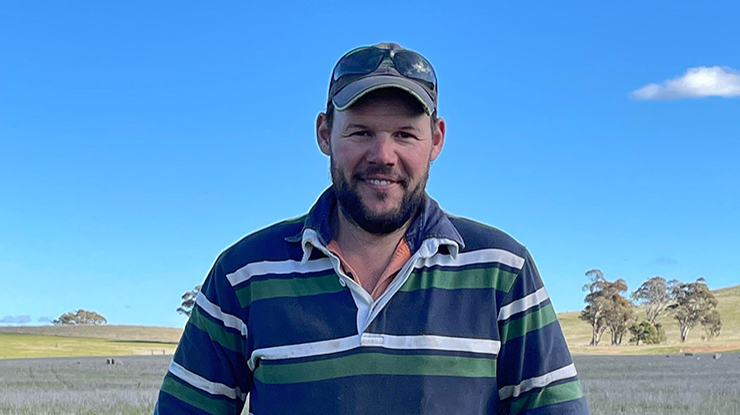 Mathew Hall in one of the limed winter active Phalaris paddocks.
Mathew Hall in one of the limed winter active Phalaris paddocks.
Perfecting the recipe for productive pastures
Liming has played a role in the Hall family’s feedbase management for almost two decades, delivering a boost to the productivity of their Victorian mixed enterprise.
Mathew Hall produces Merinos at Stawell with his wife Malinda and his parents Philip and Trudy.
Before they started treating their pastures with lime as a part of their cropping cycle 17 years ago, the pH levels in their paddocks were in the low to mid 4s.
“Within the first paddock we renovated to sow down Porto Cocksfoot on buckshot soils, the pH (CaCl2) was recorded as 4.1 before the first application of lime to our pastures,” he said.
By their tenth year of liming pastures in the spring before cropping, the Halls found their soils were still showing high levels of acidity.
“We were applying 2.5t/ha of lime after the original establishment of cocksfoot but when we tested our soils again, the pH had only improved to 4.8,” Mathew said.
In 2016, the decision was made to perform another renovation across all paddocks to move away from cocksfoot and establish Phalaris.
“While cocksfoot is a very acid-soil tolerant grass, we felt if we developed a stronger soil and feedbase management plan, Phalaris would be the way to go to get that huge quantity of highly nutritious feed,” he said.
“However, in order to achieve good establishment of Phalaris, we would have to reach a pH level at least within the low to mid 5s across all our paddocks.”
Making the change
To ensure they were making the most of their renovation and combat their soil constraints, Mathew decided to join the Perennial Pasture Systems Healthy Soils project.
“I hadn’t done a lot on soils, in fact, we’d really only attempted to deal with its constraints through liming our pastures just before cropping,” he said.
“Throughout the project we discussed combating soil acidity, and when the deliverers suggested I continue with lime, I felt a bit hesitant.”
In autumn, the Halls applied 4t/ha of lime to their soils and sowed Holdfast GT Phalaris as the pasture base, targeting a pH(CaCl2) of approximately 5.5.
“After sowing, we monitored the pastures through their first spring before reintroducing a cropping program,” Mathew said.
“The cropping program ended up being the key ingredient to our pasture improvement recipe as it created the perfect opportunity to control weeds and reapply lime in the lead up to pasture establishment.”
Benefits on-farm
The change in pasture paired with the increase of lime use has allowed the Halls to change their time of lambing from April to June.
“The additional feed wedge is ideal for ewes to lamb down on is keeping consistent during the winter, so we’re now able to have weaning occurring in spring,” Mathew said.
Better lambing and weaning times are not the only benefit the Halls have seen from their soil and pasture improvement program, they’ve also seen in increase in production.
“The combination of our steady liming over the past 17 years and more recent pasture changes has allowed for a system that has become much more productive in the past 10 years,” Mathew said.
“Since then, we have doubled our cropping program to 1,100ha and we’ve increased our ewe flock numbers by 30% to around 4,500 head.
“We are definitely seeing a return on investment.”



